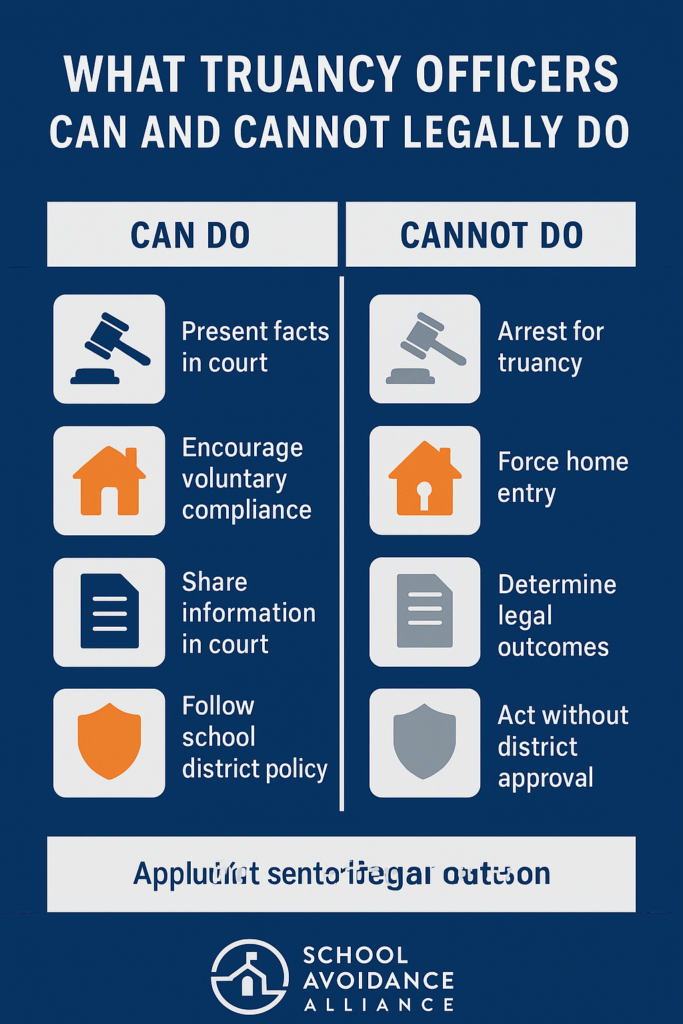Truancy officers are often the first point of contact for families facing school attendance issues. But what exactly do they do, and how can parents navigate that relationship when mental health is part of the story?
For families of students struggling with school refusal, the knock on the door from a truancy officer can feel like law enforcement rather than help. But truancy officers operate in a gray space between support and enforcement. They are charged with ensuring students attend school, but in cases where school avoidance is driven by anxiety, trauma, or disability, their involvement can either escalate stress or provide a pathway to solutions. Understanding their role, how to respond, and how to advocate for your child effectively during these interactions is critical. This article explores what truancy officers do, common pitfalls, and how families can shift the dynamic from confrontation to collaboration.
1. What Is a Truancy Officer?
A truancy officer, also known as an attendance officer, is tasked with ensuring that children attend school as required by law. They work for the school district or local government and are responsible for identifying students with frequent unexcused absences, investigating the cause, and taking action to improve attendance.
While their role may sound straightforward, it can vary widely by state and district. In some areas, truancy officers are primarily support-oriented; in others, they act as liaisons to the juvenile justice system. They serve as both monitors of student compliance and mediators between families and school systems.

2. What Do Truancy Officers Actually Do?
Truancy officers are often responsible for a broad set of tasks that include:
- Monitoring student attendance records daily or weekly
- Reaching out to families to address patterns of unexcused absences
- Visiting homes to discuss concerns and assess living conditions
- Connecting families with counseling, social services, or academic support
- Representing the school district in truancy court hearings
Some officers may drive students to school or check in daily when absences become chronic. Their behavior ranges from supportive to disciplinary, depending on district policies, training, and individual discretion.
The challenge is that many families don’t know what version of the truancy officer they’re going to get.
3. Authority and Legal Limitations
While truancy officers often seem like law enforcement, their legal powers are limited. Most are not sworn police officers and do not carry the same authority to search homes, arrest individuals, or enforce court orders without law enforcement support.
Key limitations include:
- No arrest authority: Truancy officers cannot arrest you or your child for missing school.
- Voluntary compliance: Families cannot be forced to allow home entry unless accompanied by law enforcement with a legal warrant.
- Advisory role in court: They may present facts in court, but they don’t determine outcomes.
- Dependent on school policy: Their actions are often shaped more by district guidelines than by state law.
Understanding these boundaries can help parents feel more empowered during interactions.

4. What to Expect During a Truancy Investigation
If your child has missed several days of school, and the absences are marked as unexcused, you may receive a visit or phone call from a truancy officer.
What to expect:
- Phone Outreach or Letter: Initial contact is usually through official correspondence stating the number of unexcused absences.
- Home Visit: If no response is received, an officer may show up at your home. Their purpose is to assess why absences are happening and offer next steps.
- Support or Escalation: Depending on the circumstances, they may provide a referral to support services—or escalate the case to truancy court if no progress is made.
5. Common Missteps Families Make
Families are often uncertain about how to handle contact from a truancy officer. Here are common missteps:
- Ignoring Communication: Failing to answer calls or respond to letters signals non-cooperation and can trigger quicker court referral.
- Withholding Mental Health Documentation: It’s crucial to document and disclose anxiety diagnoses, therapy sessions, or treatment plans if school refusal is involved.
- Overreacting with Defensiveness: While the presence of an officer may feel threatening, staying calm and fact-focused can help shift the tone.
- Lack of Preparedness: Not having your child’s school records, evaluation requests, or 504 documentation ready can undermine your credibility.
6. How to Work With a Truancy Officer (Not Against Them)
There are ways to redirect a truancy case away from punishment and toward support—but it starts with mindset.
Mindset Matters: Approach the interaction with the understanding that the truancy officer may not have the full picture. Assume they are operating from a place of policy, not personal judgment. Your mindset should be calm, clear, and centered on collaboration. The goal isn’t to argue, it’s to advocate. Think: “How can I help them understand my child’s reality?”
It helps to reframe the truancy officer not as an adversary, but as a potential ally who simply hasn’t yet heard your side. Avoid reacting defensively, even if the approach feels harsh. Instead, lead with empathy—both for your child and for the person who may be tasked with enforcing a broken system.
Effective Steps to Collaborate:
- Start a Dialogue: Don’t wait for them to press you—open up about your child’s mental health needs and what barriers to attendance exist.
- Offer Documentation Early: Share therapist letters, evaluation requests, medical records, and attendance logs as soon as possible.
- Ask Questions: Ask what services are available, whether the officer can connect you with a school counselor, or if your case can be reviewed by a student support team.
- Set Boundaries Respectfully: If the officer oversteps or makes assumptions, calmly state your understanding of their role and your rights.
- Request a Team Meeting: Involve the school counselor, principal, or special education coordinator. Show you are actively working on a plan.
- Follow Up in Writing: After meetings or visits, send a follow-up email summarizing what was discussed and any next steps. This protects you and shows engagement.
The most effective way to work with a truancy officer is to show that you are not avoiding responsibility—you are proactively addressing the problem in a way that centers your child’s well-being.

7. Reforming the Role: What Needs to Change
Truancy officers need clearer mandates and better training, particularly when it comes to:
Trauma-informed practices that consider how anxiety and depression manifest in school refusal.
Collaborative protocols that route mental health cases to support services, not court.
Parent education programs that inform families of their rights and the proper steps to take before court involvement.
Policy recommendations include:
Requiring training in child development and special education law
Creating non-punitive response protocols for mental health-based absences
Embedding truancy officers within student support teams—not law enforcement
Conclusion: A Role That Reflects the System’s Strengths—and Its Failures
Truancy officers are meant to be bridges—not barriers—between students, schools, and stability. When properly trained and used as part of a holistic support system, they can be instrumental in identifying struggling students and helping families access resources.
But when they act as enforcers first and allies second, families lose trust and children fall further behind.
To improve outcomes, we must redefine the truancy officer’s role—not as a disciplinarian, but as an early responder to student distress. Support, not surveillance, must be the path forward.






